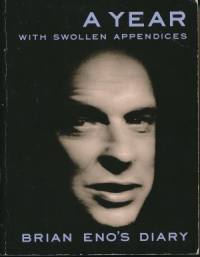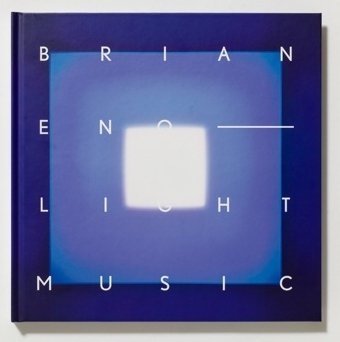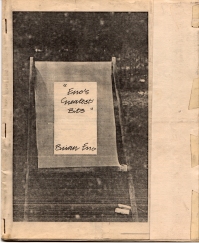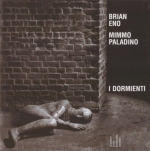 A Year With Swollen Appendices by Brian Eno
A Year With Swollen Appendices by Brian Eno
Although it's long been out of print, we start with Brian Eno's diary of 1995, written on pretty much every day of the year. Brian made the decision to censor very little, so the book
gives readers access to many areas of his life previously kept private, from
time out with the family to the music-making process; the trivial and footling
appears alongside the Big Issues. A few days just use the ambiguous
phrase "no entry" – which either means that he didn't write anything, or readers are barred from that day's content. The appendices are a collection of articles,
essays, letters and fiction, and these pages were printed on pink
paper for the first edition. If you've ever wondered what Brian is
"really like", read this book if you can get hold of it. (Faber and
Faber 1996) ISBN 0-571-17995-9.
In the mid-2000s, Canongate planned a republication which was to include new annotations and commentaries. They even got as far as creating a new cover. But that book was shelved, along with a new Eno-curated book called The Margin (intended to be a fill-it-in-yourself diary with a different curator each year).
Brian Eno Journal - Une Année aux Appendices
Gonflés par Brian Eno, traduit par Jean-Paul Mourlon
(Le Serpent A Plumes 1998) ISBN 2-84261-092-X. Brian Eno's diary, translated into
French. This edition includes a 6-track CD of previously unreleased pieces
mentioned in the text.
On Some Faraway Beach - The Life and Times of Brian Eno by David Sheppard
A 2008 biography of Brian. This will provide an excellent grounding in Eno for most readers, and Sheppard does a great job of putting Eno's work in context with contemporaneous cultural activities and events. But for those like EnoWeb who already have excessive exposure to Eno, Sheppard does not uncover much new information about his subject. Eno did not make himself very available to Sheppard, so EnoWeb at times felt a bit like like an unpaid researcher as Sheppard drew from interviews that we spent hours painstakingly scanning and correcting for our archive; there didn't appear to be much material based on Eno's multiple radio and television appearances. Another quibble is that there is a certain lack of detail: although the subtitle is "The Life and Times of Brian Eno", Sheppard's interest is clearly in the earlier Times of Eno's career, and the coverage of anything from 1990-2008 is rather thin (making up perhaps 11% of a 440-page book, for a chunk of almost 33% of a Life). There's no real reason why the making of an album like Another Green World should be covered in detail, yet not, say, Drawn From Life.
Interviewed by Tape Op in 2011, Eno said this, but don't let it put you off:
"I've never read it. I picked it up in a bookshop and read four pages, standing up. And there were four mistakes in it! They weren't very important mistakes; they didn't make any difference to anything. But I thought, "I'm just going to get annoyed if I read this."
Brian Eno: Visual Music by Christopher Scoates
The book is descibed thus: "This comprehensive monograph celebrates the visual art of renowned musician Brian Eno. Spanning more than 40 years, Brian Eno: Visual Music weaves a dialogue between Eno's museum and gallery installations and his musical endeavors—all illustrated with never-before-published archival materials such as sketchbook pages, installation views, screenshots, and more. Steve Dietz, Brian Dillon, Roy Ascott, and William R. Wright contextualize Eno's contribution to new media art, while Eno himself shares insights into his process. Also included is a download code for a previously unreleased piece of music created by Eno, making this ebook a requisite for fans and collectors." This weighty tome was the first book to take Eno's art seriously; it is out of print but as the description above states, available as an ebook. The unreleased track is called "CAM (Canada, Amsterdam, Milan)", with a running time of just under 20 minutes; it is a version of the piece that accompanied Eno's installations in those locations, as well as "Empire/Appearance" on Mistaken Memories of Mediaeval Manhattan.
 Brian Eno—Light Music by Paul Stolper
Brian Eno—Light Music by Paul Stolper
Light Music is a 100-page book from the Paul Stolper Gallery that presents a comprehensive overview of Brian Eno's exhibition at the gallery in 2016. Light Music features colour photographs of Eno's lightboxes and lenticulars, graph paper drawings, etchings, plus installation shots of the exhibition. There's a major essay by Brian charting his work in light and its influence on his music, plus a short commentary by Michael Bracewell. Light Music is limited to 1,500 copies, each individually numbered by stamp. The first 250 copies are accompanied by "Lapis Center", a signed, numbered and dated lithograph print by Eno.
Brian Eno: Oblique Music edited by Sean Albiez & David Pattie
A 2016 book of essays about Brian and his work, described thus:
"On the back of his published diary Brian Eno describes himself variously as: 'a mammal, a father, an artist, a celebrity, a pragmatist, a computer-user, an interviewee, and a drifting clarifier'. To this list we might add rock star (on the first two Roxy Music albums); the creator of lastingly influential music (Another Green World; Music for Airports); a trusted producer (for Talking Heads, U2, Coldplay and a host of other artists); the maker of large-scale video and installation artworks; a maker of apps and interactive software; and so on. He is one of the most feted and influential musical figures of the past forty years, even though he has described himself on more than one occasion as a non-musician. This volume examines Eno's work as a musician, as a theoretician, as a collaborator, and as a producer. Brian Eno is one of the most influential figures in popular music; an updated examination of his work on this scale is long overdue."
Brian Eno's Another Green World by Geeta Dayal
A 2010 book in the 33⅓ series of books examining important albums, described like this: "The serene, delicate songs on Another Green World sound practically meditative, but the album itself was an experiment fueled by adrenaline, panic, and pure faith. It was the first Brian Eno album to be composed almost completely in the confines of a recording studio, over a scant few months in the summer of 1975. The album was a proof of concept for Eno's budding ideas of 'the studio as musical instrument,' and a signpost for a bold new way of thinking about music. In this book, Geeta Dayal unravels Another Green World's abundant mysteries, venturing into its dense thickets of sound. How was an album this cohesive and refined formed in such a seemingly ad hoc way? How were electronics and layers of synthetic treatments used to create an album so redolent of the natural world? How did a deck of cards figure into all of this? Here, through interviews and archival research, she unearths the strange story of how Another Green World formed the link to Eno's future – foreshadowing his metamorphosis from unlikely glam rocker to sonic painter and producer." According to Geeta, "Eno raved about [the book], telling me it was the only really great book ever written about his work."
Brian Eno: His Music and the Vertical Color of Sound, by Eric
Tamm
(Faber and Faber 1989) ISBN 0-571-12958-7; (Updated version published by Da
Capo Press 1995) ISBN 0-306-80649-5. The first lengthy critical work to cover Eno's ideas
and music; includes discography and bibliography. Eric Tamm made his book available free online.
More Dark Than Shark by Brian Eno and Russell Mills, with
commentaries by Rick Poynor (Faber and Faber 1986) ISBN 0-571-13883-7.
A beautifully designed collection of lyrics and interpretative paintings, with
discography and critical essays. This has been out of print for years.
Brian Eno Unauthorized & Uncensored (All Ages Deluxe Edition with Videos) by R.B. Grimm
Also Un-Understood. Caveat Emptor! This hilariously poor "book" on Amazon looks like an example of one of those "Earn $$$ selling ebooks!!!" scams, which involve employing people for very little money to write you an ebook on a given topic; you then flog the ebook or earn revenue via Amazon's Kindle lending library. If you choose a musician as your topic, you stand the chance of ripping off lots of fans who want to learn more about their object of interest. But there is no new information in this titillatingly titled 27-page Large Print book, no critical analysis, nothing that merits its description as being unauthorized, nothing that would ever require censorship. The videos are just links to YouTube. Unrelated "facts" are run together and given equal weight. You could do better, even if this is your first visit to EnoWeb and you know absolutely nothing about Brian Eno. Here is the text of one chapter, which takes up a whole page, headed Controversy:
"Throughout his decade-spaning career, Brian has made it a point to let the focus of his career be on the music he produces and not on some any off-screen antic or comment he might make. As such, Brian continues to be held in high regard in Britain's music industry as a veteran music producer, songwriter and sound designer."
EnoWeb is not here to knock the writer's English, but we would like to point out that what they've written is garbage. What? You want more? Okay. Here are some bits from the Fun Facts chapter.
- He was the only non-musically trained member of Roxy Music.
- He accidentally got himself run over by a taxi in 1976 when he slipped on a wet pavement in London.
- He is the one behind the Oblique Strategies set of oracle cards.
- His only vocal performance was in the Talking Heads single, Once In A Lifetime.
- While in Roxy Music, Brian would become known as one of the more flamboyantly-dressed members of the group.
- Bryan wrote the song Dead Finks Don't Talk without the intention of maligning Bryan Ferry; he only realized that his lyrics would apply on Ferry when a friend told him so.
- He considers himself as a "painter in sound".
- He created Oblique Strategies to help writers go through various creative problems like writer's block.
"Ere. Alf, you see that geezer get knocked down by that taxi-cab yesterday?"
"Yeah, mate, I 'aven't stopped laughing since! Reckon that'll make a 'fun fact' in coupla decades!"
 Eno's Greatest Bits
Eno's Greatest Bits
A photocopied collection of lyrics, photographs and
excerpts from interviews with Brian. EnoWeb suspects these lyrics were the
foundation on which More Dark Than Shark was built. This publication was produced by Enovations, the Eno Fan Club that existed at the time. It
was also offered as an incentive for donations by a US public radio station
during 1980.
Music for a Small Boat Crossing a Medium Size River by Fernando Ortega/Brian Eno
A book of photographs from an art installation by Fernando Ortega. Amazon explains: "This volume documents Fernando Ortega's photographs of a boat taxi operating between two Mexican villages, on which the ferryman plays his CD collection. Because the trip lasts only a minute, the music is always interrupted, so Ortega asked Brian Eno to compose music for this ride. Eno's music is not included here." There is a photo of Eno's CD, but that's all. Conceptual art can sometimes feel like a bit of a joke at the viewer's expense.
New Sounds: the Virgin Guide to New Music by John Schaeffer
(Virgin 1987, UK) ISBN 0-86369-375-X. Previously published in USA as "New
Sounds". An Americo-centric survey of new music, with annotated
discographies; Eno is cited on numerous occasions.
Brian Eno by R. Bertoncelli
(Arcana Editrice, Milano, Italy,
1982)
Brian Eno. Strategie oblique by F. Destefani & F.
Massoni
(Gammalibri, Milano, Italy, 1983)
Robert Fripp: from King Crimson to Guitar Craft by Eric
Tamm
(Faber & Faber, Boston & London, 1990 ISBN 0-571-12912-9)
includes a short chapter (1 page) on Fripp & Eno.
Ocean Of Sound by David Toop
(Serpent's Tail, 1995) ISBN
1-85242-382-X. Subtitled Aether Talk, Ambient Sound and Imaginary
Worlds, David Toop's book dreamily traces the development of ambient music,
and features remembraces of -- and words from -- Brian, Kraftwerk, Aphex Twin,
Ryuichi Sakamoto and many, many more! A double CD with the same title is
available separately.
We Love You by The @mbassadors
(Booth-Clibborn Editions,
1998) ISBN 1-86154-088-4. This is a book and CD, but these people would have
you call it a "Futique" for no adequately explored reason (possibly a hilarious
play-on-words like "futile" and "clique"?) They brought together musicians and
artists for a set of collaborations. Brian provides a musical track called
"Sensual Zero Gravity" with added words and noises by Marc Quinn. The track is
an extended version of "Coasters" from The Drop. The book is hard cover,
but definitely limp.
Ray Gun: Out of Control
(Booth-Clibborn Editions) ISBN
1-86154-040-X. A collection of stuff from 3 Californian magazines; Brian makes
some sort of contribution. At £35 the EnoWeb isn't rushing to find out
what.
Incarnate: Marc Quinn
(Booth-Clibborn Editions) ISBN
1-86154-048-5. An overview of the artist Marc Quinn's output (blood, mainly).
Includes a transcript of a conversation between Brian and Marc. The EnoWeb
imagines this would be along the following lines:
BRIAN: Y'know, I
was looking at some ground coriander as I was cooking, actually, and it has
this most amazing sheen, like tiny brown stars almost...
MARC: Blood!
Blood! Blood!
BRIAN: And it struck me that television soap operas
have taken over from art schools, really, in the way that, 25 or so years ago,
if you wanted to start a band, you went to art college first, that was the way
we all did it, as we did with Roxy Music, but now if you want a pop career you
get a role acting in a soap for a few years, and then you branch out as a
musician.
MARC: Blood! BLOOD!
BRIAN: But the thing you
notice is that all the ex-soap stars sing the same kind of songs, in just the
same way that all the soaps have the same story-lines,
actually...
MARC: My book costs almost fifty quid.
BRIAN:
Bloody hell!
Brian Eno:Zaobilazne strategije ["Brian Eno: Oblique
Strategies"]
A collection of Eno's interviews from 1973-1984 including a
very long interview that Eno gave to the authors of the book, in Paris, on
January 2nd 1984. As an appendix to the interview there is a questionnaire
about Eno's favourite books, musicians, movies and similar stuff. There is only
a Serbian version in the book. [Thanks to Srdjan Djuric for this
information]
Milena Gordic adds: Hi from Belgrade! It was a very nice surprise to find out that you know about the book "Zaobilazne strategije" which was published in Belgrade in 1986, but please do not underestimate the effort of authors and please show their names: Slobodan Cicmil and Goran Vejvoda. The book is originally published in Belgrade, YU ISBN 86-7339-003-8. I hope that you will provide the right information and keep the excellent level of your site even in this detail. Thank you!
 I Dormienti
I Dormienti
Massimo & Francesca Menotti write: On
November 16th 2000 we read about a book by Brian Eno and Mimmo Paladino
titled I dormienti in an Italian music magazine. Today, after exactly
four months of enduring searching, we've finally got that book! These are the
credits:
Brian Eno/Mimmo Paladino
I dormienti
Edited by Demetrio
Paparoni
Alberico Cetti Serbelloni Editore 2000, Milano, Italy
ISBN
88-88098-00-3
Edition of 2000
Price 67,14 Euro - 70,00 US$
The book is in a boxed luxury edition, with b/w and color photographs by Peppe Avallone of the Roundhouse exhibition and some sketches by Mimmo Paladino and Brian Eno. The text is both in Italian and in English. The compact disc includes the same track as the 1999 Opal Music edition, but with a different label.
Quote from the last page: "This book is printed in an edition of 2000 by Alberico Cetti Serbelloni Editore in Milan. It contains a CD of music composed specifically by Brian Eno to accompany I dormienti, The Sleepers, an exhibition of work by Mimmo Paladino and Brian Eno shown in the Undercroft of London's Roundhouse. 100 copies of this book are in a special edition accompanied by an aquatint etching with drypoint and presented in a fired terracotta case, both designed by Mimmo Paladino."
EnoWeb adds: Very heavy book.
Image provided by radiocitizen.
Zeitgeist by Bruce Sterling
Gordon Osse writes:
Here's a reference to Eno in a book I'm reading (which I recommend):
"Hear anything from Eno lately?" Starlitz prodded.
"I know him back in Roxy Music," Makoto said by reflex. "I know Brian Eno when he wear makeup and feathers."
"D'you read his new book? The one about a year in the 1990s?"
"Professor Eno very good writer," Makoto admitted sourly. He rolled his tongue inside his mouth and slowly emitted a quote. "'Not doing the thing that nobody had ever thought of not doing.'"
Starlitz pondered this remark. Not many Europeans could have written that sentence. "Eno is heavy, man."
"I keep diary for year 1999 now, 'Oblique Strategy.'" Makoto looked up, stirring the noodle pot languidly.... [pp. 196-197]
Kraftwerk - I Was A Robot by Wolfgang Flür [ UK edition
published by Sanctuary Publishing Limited; ISBN: 1-86074-320-X ]
Girls!
Girls! Girls! all the way as Kraftwerk's one-time drummer traces his life from
humanity to android and back again. Poor Wolfgang is prevented from telling the
full story by legal action. We mention the book here for the quote from Christa
Fast, the widow of Conny Plank:
"Brian Eno was completely different [from the embedded image/attitude of Kraftwerk -- EnoWeb]. He was capable of behaving quite normally in private with Conny, Moebius, Roedelius and Devo when he was working here in the studio, and yet he instantly became the cult figure as soon as a journalist turned up. It was fascinating, witnessing the switch. For him, it was part of his job to play this game, but his personality remained unaffected, uncontaminated by the image that he presented to the media world..."
Rockers, Jazzbos & Visionaries by Bill Milkowski
Published by Billboard Books, this is
a collection of interviews; Brian is one of the Visionary interviewees.
The Book of Inspirations
David Cooper Orton writes: Having
just returned from holiday in Cornwall (whilst in St Ives I found a copy of the
Fourth Door Review which was a pleasant co-incidence) I've been working my way
through several weeks of New Scientist back-copies which have accumulated on my
desk. The August 19th edition (p49) mentions The Book of Inspirations,
published by The Institute for Social Inventions, and with (apparently)
an enthusiastic introduction by Brian. Not finding it listed at amazon.co.uk,
further investigation reveals that it seems to be available only as part of a
£15 subscription, which includes a: "book-length Annual in July/Aug each
year. The annual until July 15th 2001 is called 'The Book of Inspirations - A
directory of Social Inventions'. 320 pages. The musician and writer Brian Eno
writes: 'Civilisation is embodied social imagination. This is a book about
it'."
Cornucopia of Ideas
A compendium of ideas collected by the
Global Ideas Bank -- everything from what to do with medication reaching its
use-by date to moving the Earth... from following another religion for one day
each year to repairing coral reefs with eco-friendly concrete balls... Brian
contributes a preface paying tribute to Nicholas Albery, the founder of the
Institute of Social Inventions who died in 02001. His preface also highlights
the potential impact of "the more modest ideas that turn out to make a big
difference." ISBN 0 948826 58 4. Look out also for Seize The Day
-- 366 Tips for Living which has a foreword from Brian.
Before And After Eno
A biography of Brian by Marco Calloni, published by Meridiano Zero (Odoya) in Italian. Marco says:
"In the 336 pages I talk about Eno's 'history' from the beginning, art schools, education, then experiences with Cornelius Cardew, Roxy Music, solo albums and so on... Naturally there's a big part of the book dedicated to Ambient music and labels and of course almost 'any' or better 'many' of his collaborations and productions."
Want more bed-time reading?
Take a look at our
on-line interviews & articles archive.
